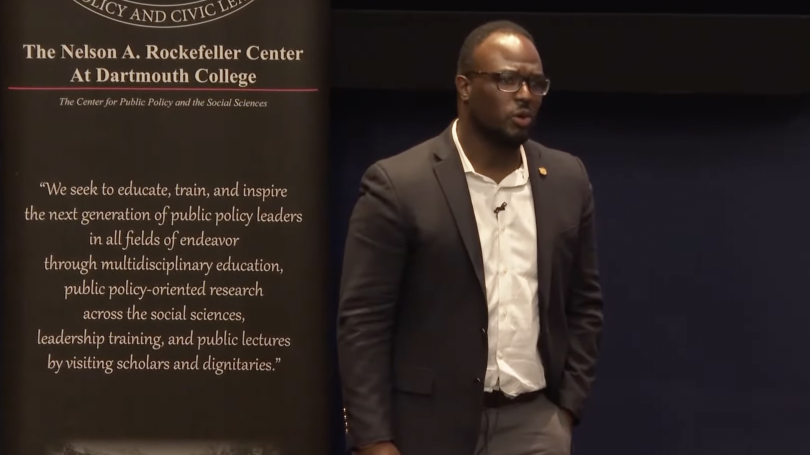
- Public Policy
- Leadership
- Funding
- News & Events
- About the Center
Back to Top Nav
Back to Top Nav
Back to Top Nav
Back to Top Nav
On May 26, 2022, the Rockefeller Center hosted a lecture by Professor Morgan C. Williams, Jr., Assistant Professor of Economics at Barnard College, Columbia University. Co-sponsored by the Department of Economics and introduced by Department Chair Professor Andrew Samwick, the event featured a discussion of Professor Williams's paper co-authored with Aaron Chalfin, Benjamin Hansen, and Emily Weisburst, titled "Police Force Size and Civilian Race." As the first empirical exploration of race-specific effects of larger police forces in the United States, Professor Williams explained the background, methodology, and numerical results behind his analyses, followed by a question-and-answer session with the audience moderated by Research Assistant Professor of Government Herschel Nachlis.
In presenting the motivation for his group's paper, Professor Williams noted just how much "faith in policing, at least as we surveyed it, has been declining" in the United States, as evidenced by sentiments on mainstream and social media platforms. While movements such as Black Lives Matter have played an important role in "redefining our attention with respect to exactly what do we want from policing", he explained, discourse around the country surrounding campaigns to "defund the police" have challenged policymakers to reconsider how best to "prioritize policing in terms of our approach to public safety." While the resulting discussions have shaped positive policy outcomes in major US cities, recent increases in violence and gun violence over the past year have "added a new wrinkle" to how people want to approach public safety issues, Williams said, especially in vulnerable communities.
Existing empirical research concluded that expansion of a police force, whether through an increase in the number of police employed or through improved visibility of an existing force, reduces crime. These findings, as well as Williams's identity as a "scholar of race first and economist second," motivated him to more deeply understand the role of race not only in economic behavior, but also with respect to "inequality within crime and criminal justice in the United States."
Given that there are some benefits to expanding the police force for public safety, do communities of differing racial compositions benefit equally from such reforms? The existing literature, which approaches these questions from a variety of different perspectives and focuses on policing strategy, gave Williams and his colleagues reason to believe that public safety returns from policing may actually differ across races and/or communities.
With this in mind, Williams and his co-authors used police employment data from 242 cities between 1990 and 2018 to assess the effect on public safety of adding a single police offer to a police force. Specifically, their results explore effects on the number of "non-justifiable" (i.e. civilian-on-civilian) non-Hispanic Black and White homicides, the number of index arrests and crimes (e.g. for more serious crimes such as rape, robbery, murder), and the number of quality-of-life arrests (i.e. generally misdemeanors punished by fines not jailtime).
Using their empirical methodology, Williams and his co-authors found that in the case of homicides, increasing police force size saves lives for both Black and White Americans; however, the impact is twice as large for black victims when results are adjusted per capita. More specifically, saving one additional life from homicide requires 10-17 more officers on average. Using a 2019 paper from co-author Emily Weisburst concluding that 2.5% of arrests lead to use of force, Williams also explained that an additional police officer likely meant 7 to 10 more use-of-force incidents, of which 4 to 5 include a Black civilian. Meanwhile, not only does the addition of one police officer abate an average of 18 to 24 index crimes, but it also reduces index arrests by 1-2 on average, suggesting that a greater police presence alone could also have positive public safety outcomes. Furthermore, the reduction of these index arrests is 4 to 6 times greater for Black Americans—an especially important conclusion, Williams explained, because "we often associate these offenses with lengthy prison sentences."
At the same time, Williams noted, an increase in police force size by one officer increases quality-of-life arrests by between 7 and 22 arrests on average, with liquor law and drug possession arrests being 2.5 to 3 times larger for Black Americans. Although Williams and his co-authors were able to pinpoint this large discrepancy across races, Williams explained that their empirical analysis is inherently limited in terms of its ability to pinpoint the exact reasons for these differences. "Maybe there might be a discrimination story or bias story that's at play; we can't necessarily speak to that through our results, because there's also the possibility that maybe there might be differences in demand for this sort of policing and also offending behavior that we're just not simply able to disentangle through the type of study design that we're using here," he said.
While Williams mentioned that his paper was able to "provide some kind of novel insight about how the benefits and costs" of larger police force size would look when accounting for race, he also acknowledged that it was only "one narrow accounting of how we should think about the impact of police force expansion on criminal behavior or enforcement activity." In examining ways of translating formal analyses— such as those within his paper—into concrete, actionable policy, Williams argued that a larger conversation was needed to think about bridging the way a "community perceives their public safety needs and how policymakers perceive their public safety needs." In doing so, he advised, policymakers shouldn't necessarily discount the other existing research literature exploring other public safety options. "Policing in itself is not a panacea for addressing public safety, it's just one important tool among many."
-- Written by Shawdi Mehrvarzan '22, Rockefeller Center Student Assistant for Public Programs